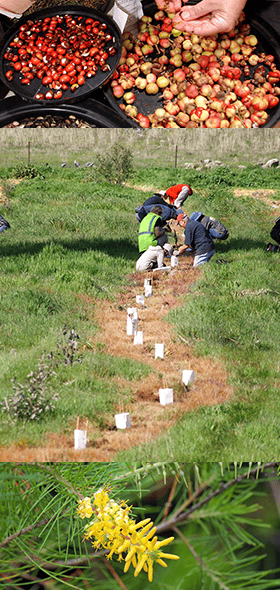Glossary
Adaptive capacity: The ability to evolve and adapt to a new environment
Adaptive management: Used in situations where despite uncertainty, decisions and actions must be made and acted upon. The process acknowledges that the information used to make these decisions is incomplete and therefore may be incorrect. Emphasizes learning from the outcomes of these decisions to inform future decision-making
Ecosystem services: Processes or services provided by species and ecosystem, e.g. crop pollination by insects
Evolutionary potential: The potential to evolve
Germplasm: Seed or other regenerative material
In-situ: In the original place
Niche space: Realized niche space the area that a species occupies vs Available niche space the area that is suitable for that species to occupy (but the species is not present)
Introduction
Climate change is no longer just a concern for the distant future. Australian temperatures have increased by almost 1°C since 19101 while rainfall, and the intensity and frequency of extreme weather events such as floods and droughts, are also changing. We are already witnessing shifts in species’ distributions, and changes in life cycles, populations and physiology, consistent with responses to the relatively modest climatic change of the past few decades. As species continue to respond to the changing climate, we will see accelerating changes in the composition and structure of ecological communities and the ecosystem services they provide.
Rapid environmental change presents challenges and uncertainties for landscape managers. Many restoration and revegetation practitioners recognise that changes to current practices are needed, based on understanding habitat conditions expected in the future, rather than the historical baseline of the past2. But how should natural landscapes be managed when the magnitude and direction of projected changes are uncertain and the conditions projected for local sites may not have been previously experienced?
This Guide provides information on how to use on-line tools to gauge if existing vegetation (species and local populations) are likely to be sustained as the climate changes. To make these decisions, information on climate projections for the revegetation site, the climatic tolerance of the existing species (as indicated by species’ distributions), and the likelihood of survival of local populations are required. The Guide provides step-by-step instructions on how to (1) find and use on-line regional climate projections for a local site; (2) evaluate which plant species may be sustained at the site in the future; and (3) consider which strategy for selecting provenances will increase the likelihood of the local population surviving in the future (Figure 1).
These steps are designed to acknowledge uncertainties about the nature and scale of physical change and to support the development of strategies that are as robust and climate-ready as possible, given our current knowledge (see Box 1). The focus is on maintaining the adaptive potential of species and vegetation communities, through careful species and provenance selections, and through maximizing genetic diversity. The Guide should be used to refine a provisional planting list that has considered all other aspects of suitability (such as soils, propagule availability etc.).
Robust decision making for an uncertain future
A major challenge for planning climate-ready revegetation is that we cannot know exactly what the future climate at a particular time at a particular site will be, or precisely how any individual species will respond. However, we do know that change will continue to occur and that we need a flexible decision-making process based on the best available science. The greenhouse gases already emitted have most likely locked the world into at least another degree of warming over the next few decades, although the climate in the second half of the century will depend on the success of emissions reduction strategies. But even if greenhouse gas emissions were to cease immediately, impacts on the climate may still be felt for many decades, possibly centuries, to come3. Uncertainty cannot be an excuse
for inaction or for business-as-usual, because decisions made now will have long term consequences.
There are several ways in which decisions can be made more robust to the uncertainty inherent in planning for the future4. Wherever possible, we need to select options and strategies that:
- Enhance resilience and adaptive capacity;
- Will be effective under a range of possible future climates;
- Have multiple benefits and are low or no-regret;
- Promote adaptive management and contribute to improved understanding;
- Allow flexibility.
Climate trends in Australia
Australia has experienced warming of 0.09°C per decade since 19115, and mean temperatures are projected to continue rising this century6. By 2030, the annual mean temperature in Australia is projected to increase by 0.6 to 1.3°C (compared to 1986–2005), with little difference between emissions scenarios (see Box 2). The magnitude of change later this century depends on the trajectory of global emissions. At the current rate of emissions, temperatures are projected to rise by as much as 2.8 to 5.1°C by 20907. Even if a strong mitigation policy led to emissions peaking around 2040 before declining, temperature increases of between 1.4 and 2.7°C are projected7.
The magnitude and rate of current and projected climate change varies among regions. Future temperature increases are projected to be higher in inland Australia and the Australian Alps, and lower in coastal areas and islands, including Tasmania. Changes to rainfall are also projected to vary between seasons and regions, but generally, wet areas are projected to become wetter and dry areas to become drier7. Topography will influence the changes in climate experienced at a local site or microhabitat scale.
As average temperatures continue to increase, changes in the frequency and/or intensity of extreme events will also continue. Extreme hot days are already more frequent, as is the frequency, intensity and length of heatwaves. Extreme rainfall events will continue to increase, with more intense rain falling in shorter periods, increasing runoff and soil erosion7. Changes in extreme events, especially for hot days and periods of drought, rather than changing average conditions, are critically important for plant mortality. In ecosystems such as coastal wetlands, acceleration of sea level rise also needs to be considered, as well as the associated increases in the frequency and severity of coastal flooding during storms.
The risk of extreme fire danger weather, especially in southern Australia is increasing8, driven by increasing temperatures and long-term declines in cool season rainfall9. The Australian fire season is
 also lengthening10, with significant implications for the ability of fire management agencies to conduct hazard reduction9. Increasing frequency and severity of fire regimes is very likely to be one of the most important drivers of ecosystem change in coming decades11.
also lengthening10, with significant implications for the ability of fire management agencies to conduct hazard reduction9. Increasing frequency and severity of fire regimes is very likely to be one of the most important drivers of ecosystem change in coming decades11.
Emissions scenarios
Future greenhouse gas emissions will be affected by a complex array of interacting factors, including changes in human population size and demography, technology developments, and policy changes by governments. The Intergovernmental Panel on Climate Change (IPCC) has developed a set of emissions scenarios to underpin climate projections, based on four alternative combinations of global trends. These are called Representative Concentration Pathways (RCPs) and range from RCP2.6 (lowest) to RCP8.5 (highest) emissions scenario with RCP4.6 and RCP6 representing intermediate pathways6.
Global emissions are currently tracking at the higher end of the RCP8.5 pathway12. This pathway does not include any mitigation target, resulting in considerable increases in greenhouse gas emissions over time, and a radiative forcing (amount of energy reaching the earth’s surface) of 8.5Wm2 by the end of the century. RCP8.5 projects increases in global mean temperatures of 2.6–4.8°C for 2100 (relative to 1990). If the most recent pledges for emissions reductions of nations that are signatories to the UNFCCC are met, the world is on track for warming of 2.7–3°C in the latter half of the century13.

The ANPC is proud to be hosting ‘Climate-ready revegetation – a guide for natural resource managers’ on behalf of the authors. However its content has not yet been formally endorsed as ANPC policy. The ANPC suggests that any user of the guide should carefully consider its appropriateness to their particular circumstances. The field of climate-anticipatory revegetation is still developing, is locally contingent, and should be considered in conjunction with established best practice
